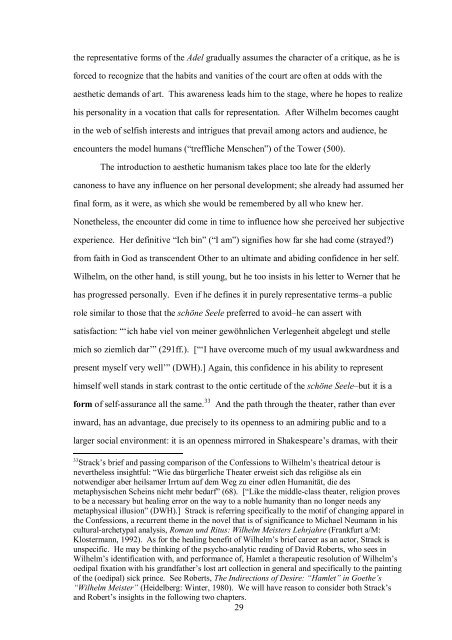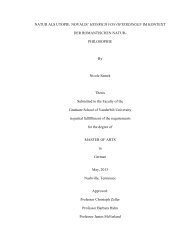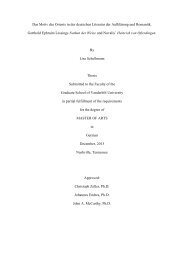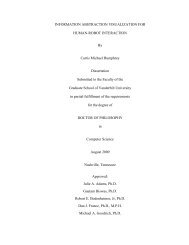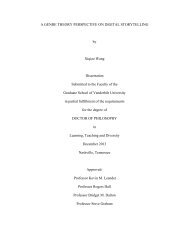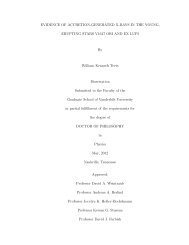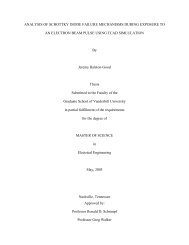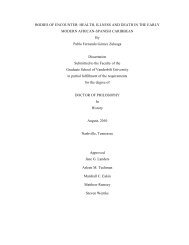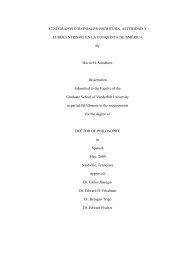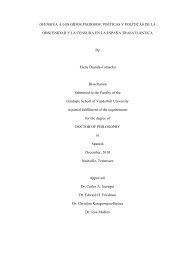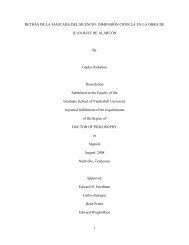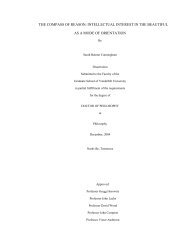THE DEATH OF DIONYSOS - ETD - Vanderbilt University
THE DEATH OF DIONYSOS - ETD - Vanderbilt University
THE DEATH OF DIONYSOS - ETD - Vanderbilt University
You also want an ePaper? Increase the reach of your titles
YUMPU automatically turns print PDFs into web optimized ePapers that Google loves.
the representative forms of the Adel gradually assumes the character of a critique, as he is<br />
forced to recognize that the habits and vanities of the court are often at odds with the<br />
aesthetic demands of art. This awareness leads him to the stage, where he hopes to realize<br />
his personality in a vocation that calls for representation. After Wilhelm becomes caught<br />
in the web of selfish interests and intrigues that prevail among actors and audience, he<br />
encounters the model humans (“treffliche Menschen”) of the Tower (500).<br />
The introduction to aesthetic humanism takes place too late for the elderly<br />
canoness to have any influence on her personal development; she already had assumed her<br />
final form, as it were, as which she would be remembered by all who knew her.<br />
Nonetheless, the encounter did come in time to influence how she perceived her subjective<br />
experience. Her definitive “Ich bin” (“I am”) signifies how far she had come (strayed?)<br />
from faith in God as transcendent Other to an ultimate and abiding confidence in her self.<br />
Wilhelm, on the other hand, is still young, but he too insists in his letter to Werner that he<br />
has progressed personally. Even if he defines it in purely representative terms–a public<br />
role similar to those that the schöne Seele preferred to avoid–he can assert with<br />
satisfaction: “‘ich habe viel von meiner gewöhnlichen Verlegenheit abgelegt und stelle<br />
mich so ziemlich dar’” (291ff.). [“‘I have overcome much of my usual awkwardness and<br />
present myself very well’” (DWH).] Again, this confidence in his ability to represent<br />
himself well stands in stark contrast to the ontic certitude of the schöne Seele–but it is a<br />
form of self-assurance all the same. 33 And the path through the theater, rather than ever<br />
inward, has an advantage, due precisely to its openness to an admiring public and to a<br />
larger social environment: it is an openness mirrored in Shakespeare’s dramas, with their<br />
33<br />
Strack’s brief and passing comparison of the Confessions to Wilhelm’s theatrical detour is<br />
nevertheless insightful: “Wie das bürgerliche Theater erweist sich das religiöse als ein<br />
notwendiger aber heilsamer Irrtum auf dem Weg zu einer edlen Humanität, die des<br />
metaphysischen Scheins nicht mehr bedarf” (68). [“Like the middle-class theater, religion proves<br />
to be a necessary but healing error on the way to a noble humanity than no longer needs any<br />
metaphysical illusion” (DWH).] Strack is referring specifically to the motif of changing apparel in<br />
the Confessions, a recurrent theme in the novel that is of significance to Michael Neumann in his<br />
cultural-archetypal analysis, Roman und Ritus: Wilhelm Meisters Lehrjahre (Frankfurt a/M:<br />
Klostermann, 1992). As for the healing benefit of Wilhelm’s brief career as an actor, Strack is<br />
unspecific. He may be thinking of the psycho-analytic reading of David Roberts, who sees in<br />
Wilhelm’s identification with, and performance of, Hamlet a therapeutic resolution of Wilhelm’s<br />
oedipal fixation with his grandfather’s lost art collection in general and specifically to the painting<br />
of the (oedipal) sick prince. See Roberts, The Indirections of Desire: “Hamlet” in Goethe’s<br />
“Wilhelm Meister” (Heidelberg: Winter, 1980). We will have reason to consider both Strack’s<br />
and Robert’s insights in the following two chapters.<br />
29


